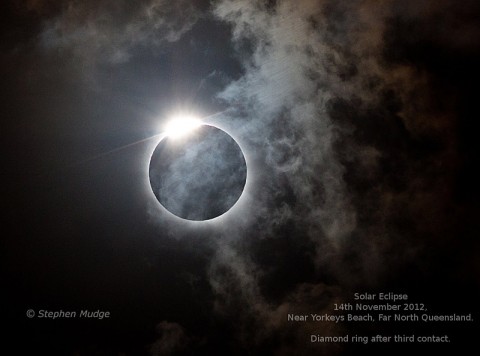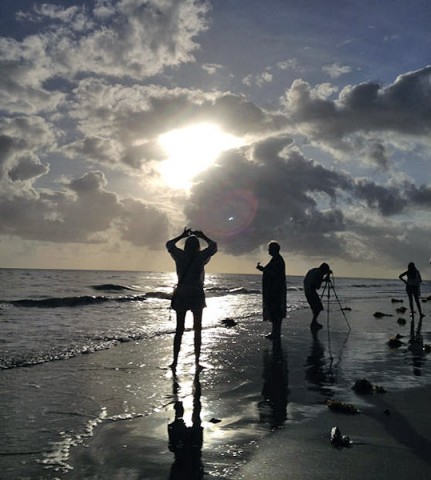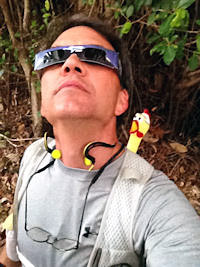Written by Dr. Tony Phillips
Science at NASA
 Washington, D.C. – Astrophysicist and legendary eclipse chaser Fred Espenak has a rating scheme for natural wonders. “On a scale of 1 to 10,” he says, “total eclipses are a million.”
Washington, D.C. – Astrophysicist and legendary eclipse chaser Fred Espenak has a rating scheme for natural wonders. “On a scale of 1 to 10,” he says, “total eclipses are a million.”
Apparently, this true even when the eclipse is almost completely clouded out.
Last week, I experienced such an eclipse on Four Mile Beach outside the resort town of Port Douglas in Queensland, Australia. For years, tourists, astronomers and eclipse chasers had been anticipating a fantastic show over the Coral Sea on November 14th, 2012.

The night before the eclipse was crystal clear, with all of the stars of the southern sky twinkling brightly overhead. As dawn broke, however, there were clouds on the horizon, and by 6:30 am local time, less than 10 minutes before totality, thousands of people on the beach watched in dismay as a patchy bank of fluffy white clouds rolled right in front of the sun.
That’s when I learned that even a cloudy eclipse is off the scale.

Even as we were urgently wishing the clouds away, I realized their benefit: Clouds act as a natural filter. The partially-eclipsed sun burned an auburn crescent through the gray fluff overhead. Onlookers unwisely but irresistibly took off their eclipse glasses for the kind of direct view that would have been impossible under clear skies. It was mesmerizing.
At that point, only one thing could tear our eyes off the sky: The arrival of the Moon’s shadow. We felt it before we saw it. Even at 6:30am in the morning, the beach was hot and humid. Suddenly, we were enveloped by an unexpected chill. We looked around to see the landscape rapidly darkening. Tropical birds that had been flitting noisily back and forth in the canopy of nearby trees paused, and an otherworldly silence descended on the beach.
The operative word is “otherworldly.” The Moon’s shadow lances more than a quarter million miles across the dark vacuum of space, and when it lands on a beach in Australia, it seems to bring a bit of the silent cold with it. Something undeniably cosmic was in the air.
I turned to my daughter, 16 year old Amelia, and involuntarily cried out in a loud voice, “Oh my God, look!” (As if she wasn’t already.)
The beach erupted in cries of delight for … one-one thousand, two-one thousand, three one-thousand … a long count of three, and then the clouds closed again. The eclipse vanished.
Totality was supposed to last two minutes, and we had only seen three seconds of it. Remarkably, no one seemed to mind. Along the Four Mile Beach, thousands of people stood in the cool center of the Moon’s shadow, wrapped in lunar darkness, staring mesmerized at the cloudy spot where the eclipse was playing out behind a puffy gray veil of water droplets. One brief glimpse of the sun’s corona had sent an electric jolt through the crowd, and we were frozen to the spot.
One minute and 57 seconds later (an interval that seemed much shorter) the Moon slid off the solar disk. The clouds abruptly blossomed with light. It looked like an explosion had taken place in the atmosphere not far above our heads. Iridescent colors appeared around the edge of the clouds as water droplets diffracted the rays of surging light.
I’m pretty sure that no one on the beach was disappointed.
There was only one last thing to do: Run a marathon.
For the first time ever, runners had organized a 26.2 mile race with an eclipse as its starting gun. The end of totality was our signal to assemble at the starting line and high-tail it through the verdant forests and cane fields of northeast Queensland. My running partner was NASA’s rubber chicken Camilla, who would complete the marathon in support of the space agency’s “Train Like an Astronaut” program, the first rubber chicken to accomplish such a feat.

The partial eclipse was still underway as hundreds of runners flooded through the starting gate, so most of the athletes still had their eclipse glasses with them. As the clouds dispersed, we could look up and see the sun reshape itself from a thin sliver to a fat crescent, and ultimately a complete circle again. Experienced runners are accustomed to seeing empty packets of energy gels littering the path of long races. In this marathon, the path was lined instead with discarded eclipse glasses.
Before long, the sky was completely clear and the hot Australian sun beamed down on the runners. Temperatures climbed to nearly 90 degrees, and the Queensland humidity pushed the Heat Index close to 100 F. We were definitely missing our clouds! To combat the heat, I remembered the feel of the Moon’s cool shadow and in my mind replayed over and over again the three seconds of totality I had witnessed–a mental movie that was still playing when Camilla and I crossed the finish line more than 4 hours later. Even now, I can’t quite get it out of my mind.
Maybe a million is an underestimate, after all.


